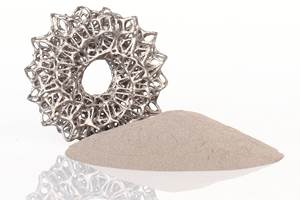Sidus Space Successfully Launches LizzieSat Hybrid 3D-Printed Satellite
The hybrid 3D-printed satellite was manufactured using Markforged 3D printers for parts that would be incredibly lightweight, durable and custom to the structure to ensure the satellite remains intact during launch and works properly for its full life span in space.
Sidus Space has utilized Markforged 3D printers to fabricate components quickly and effectively for multiple programs, enabling the company to meet customer requirements in a cost-effective and timely manner. Source: Sidus Space
Sidus Space, a multifaceted space and data-as-a-service satellite company, has successfully launched and deployed its LizzieSat satellite to low Earth orbit as part of SpaceX’s Transporter-10 Rideshare mission. Liftoff occurred on March 5 from Space Launch Complex 4 East at Vandenberg Space Force Base in California.
The hybrid 3D-printed satellite was manufactured using Markforged 3D printers for parts that would be incredibly lightweight, durable and custom to the structure to ensure the satellite remains intact during launch and works properly for its full life span in space.
The primary mission of the LizzieSat platform is offering customized intelligence to support various industries, including agriculture (crop health), environmental (assessing deforestation, climate change) and maritime (shipping routes) with its on-orbit satellite technology.
The successful deployment of LizzieSat signifies a monumental achievement for Sidus Space, marking its entrance into the next era of space technology and data services. To rewatch the live mission webcast, visit spacex.com or sidusspace.com.
“We are thrilled to announce the successful launch of our first LizzieSat satellite,” says Carol Craig, Sidus Space founder and CEO. “This accomplishment is a testament to the dedication, expertise and collaboration of our team. LizzieSat epitomizes our commitment to pushing the boundaries of space technology and advancing our mission of Bringing Space Down to Earth.”
Markforged has been a a key player in Sidus’ 3D-printed LizzieSat satellites. “Markforged 3D printers initially played an important role in our successful External Flight Test Platform (EFTP) mission, an on-orbit external experimental facility that was hosted on the NanoRacks International Space Station External Platform (NREP),” Craig says. “Building on the success of our EFTP program, we have continued to leverage Markforged solutions in the development of LizzieSat.”
By utilizing Markforged 3D printers, Sidus Space has been able to fabricate components quickly and effectively for multiple programs, which enables the company to meet customer requirements in a cost-effective and timely manner.
Sidus Space’s LizzieSat multipurpose constellation is designed to meet the precise conditions of commercial and governmental demands in an increasingly interconnected, cloud-based and data-driven world. The LizzieSat platform aims to take advantage of a shift away from static and low-frequency satellite imaging and geospatial solutions toward on-demand access of real-time geospatial intelligence.
LizzieSat is positioned to revolutionize space-based data collection and analysis with its innovative Space Platform with a Purpose and FeatherEdge AI integration. This mission aims to broaden its customer base across military and commercial sectors, offering tailored intelligence solutions for industries such as defense, agriculture, maritime, and oil and gas.
As the LizzieSat mission progresses, Sidus Space says it remains steadfast in its commitment to delivering cutting-edge solutions and pushing the frontiers of space technology and data collection. The company looks forward to upcoming missions, with LizzieSat-2 and LizzieSat-3 expected to launch on future SpaceX Rideshare missions.
To see how Markforged 3D printed a satellite with Sidus Space, watch this video.
“Markforged has been an incredible partner to us over the years,” Craig adds. “We are honored to be highlighted in one of their videos, as it speaks to our commitment to providing innovative, reliable and cost-effective solutions to our customers.”
Related Content
7 Takeaways From America Makes MMX 2023
America Makes just held its recent Members Meeting & Exchange. Here are observations related to cost and collaboration; digital manufacturing; and the sustainment and supply chain needs of the DoD.
Read MoreSintavia Develops Niobium Printing Technology for Aerospace, Defense
C103 material parameter specification is said to enable full alloy adoption across defense and space applications.
Read MoreAmerica Makes Announces Winners for IMPACT Project Call
The project call focuses on additive manufacturing research related to casting and forging, metal powder sourcing and robotic AM process planning for continuous fiber-reinforced composite structures.
Read MoreFrom Polymer Tooling to Metal Production Via 3D Printing
As Azoth has adopted new additive manufacturing technologies, its work has transitioned from tooling to production parts for automotive, medical and defense.
Read MoreRead Next
3D Printing Brings Sustainability, Accessibility to Glass Manufacturing
Australian startup Maple Glass Printing has developed a process for extruding glass into artwork, lab implements and architectural elements. Along the way, the company has also found more efficient ways of recycling this material.
Read MoreHybrid Additive Manufacturing Machine Tools Continue to Make Gains (Includes Video)
The hybrid machine tool is an idea that continues to advance. Two important developments of recent years expand the possibilities for this platform.
Read More4 Ways the Education and Training Challenge Is Different for Additive Manufacturing
The advance of additive manufacturing means we need more professionals educated in AM technology.
Read More























